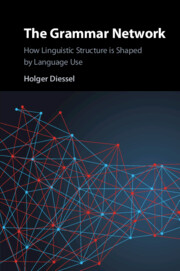Part I - Foundations
Published online by Cambridge University Press: 12 August 2019
Summary
Chapter 2 provides a background on the use of network models in different scientific disciplines and introduces the general architecture of the grammar network. The proposed network model has two levels of analysis: a lower level, at which linguistic signs, notably constructions, are defined by three different types of associations, or relations: (1) symbolic relations connecting form and meaning, (2) sequential relations connecting linguistic elements in sequence and (3) taxonomic relations connecting linguistic patterns at different levels of abstraction. Together the three relations define the basic units of speech, i.e., lexemes and constructions. Every unit constitutes a (local) network shaped by language use, but these networks also serve as nodes of a higher-level network that involves three other types of relations: (4) lexical relations connecting lexemes with similar or contrastive forms and meanings, (5) constructional relations connecting constructions at the same level of abstraction and (6) and filler-slot relations connecting particular lexemes with constructional schemas.
Keywords
Information
- Type
- Chapter
- Information
- The Grammar NetworkHow Linguistic Structure Is Shaped by Language Use, pp. 7 - 40Publisher: Cambridge University PressPrint publication year: 2019
